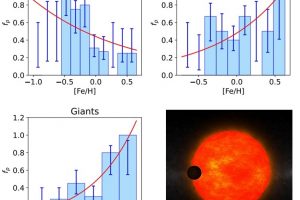The relation between stellar metallicity and presence of giant planets in intermediate massive stars described in the study: “Intermediate-mass stars and the origin of the gas-giant planet-metallicity correlation” of J. Maldonado (INAF-OAPA)

As of today (February 2025), out of the 5834 identified exoplanets, only about 5% orbit stars with masses between 1.5 and 3.5 solar masses (intermediate-mass stars). This is likely due to specific difficulties in exoplanet detection techniques, difficulties that are not encountered for lower-mass stars. For example, since they are more luminous than lower-mass stars, the transit depth (i.e., the decrease in stellar brightness during a planet’s passage in front of the star along our line of sight) is smaller. This makes it more challenging to study the relationships between stellar properties, the probability of hosting planets, and the architecture of planetary systems.
For low-mass stars, for instance, a well-known relationship confirmed by several studies exists between the probability of hosting gas giant planets and the star’s chemical abundance of elements heavier than hydrogen and helium (referred to as “metallicity”). This relationship is interpreted as a consequence of the fact that a lower abundance of heavy chemical elements in the star—and therefore in its protoplanetary disk, where planet formation occurs—makes it less likely for massive planetary cores to form, which are necessary for the creation of gas giant planets. For example, it is worth noting that Jupiter formed from a rocky core with an estimated mass of about 10-12 Earth masses.
In their study, “Intermediate-mass stars and the origin of the gas-giant planet-metallicity correlation“, recently published in the journal Astronomy and Astrophysics, a team of researchers led by astrophysicist J. Maldonado (INAF – Osservatorio Astronomico di Palermo) analyzed a sample of 131 intermediate-mass stars in different evolutionary phases: pre-main sequence, main sequence, and giant phase. Throughout this evolution, stars in this mass range undergo internal structural changes: they start as fully convective during the pre-main sequence, develop an outer radiative region before the main sequence, and then become fully convective again in the giant phase.
From the analysis of this stellar sample, it emerged that the relationship between the probability of hosting gas giant planets and metallicity depends on the star’s evolutionary phase. No correlation was found for pre-main sequence stars, while for main sequence stars, a relationship is possible but not statistically significant. However, for giant stars, the relationship is strong. The researchers interpreted this result as a consequence of the star’s internal structure and the accretion of material poor with heavy elements during the pre-main sequence phase. Planet formation would, in fact, reduce the amount of heavy elements accreted by the star in its early evolutionary stages. The development of a radiative layer during the pre-main sequence would then limit the mixing of chemical elements within the star, making the measured metallicity not fully representative of the star’s actual composition. However, during the giant phase, the star becomes fully convective again, remixing chemical elements within itself and allowing its true metallicity to be measured once more.
The cover image (click here to view it in full) shows the observed relationships between the fraction of stars hosting planets and metallicity for intermediate-mass stars in the three evolutionary phases.
Mario Giuseppe Guarcello
Follow MarioSpiegaCose on Instagram () , Facebook (), Youtube (), and X ()
Follow the Astronomical Observatory of Palermo on Facebok and on Instagram
Subscribe the Youtube channel of the Astronomical Observatory of Palermo
